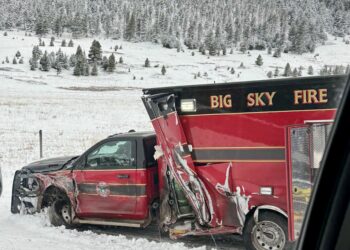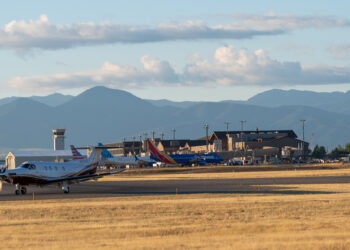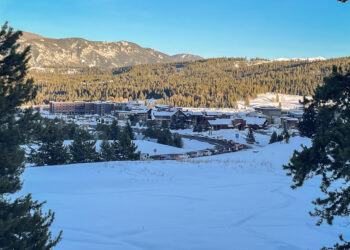By Tyler Allen
Explore Big Sky Senior Editor
BIG SKY – It’s the namesake of the local high school’s mascot. It inspires tourists to stop and poke their cameras out of car windows. The Spanish Peaks bighorn sheep herd is a Big Sky icon.
During the winter, this herd can be found licking salt off Lone Mountain Trail and Highway 191, occasionally to their peril – and the peril of motorists.
On Jan. 27, a propane truck heading westbound on Lone Mountain Trail swerved to miss a bighorn sheep that ran into the road. The driver swerved to avoid the animal, overcorrected and flipped the truck into the ditch.
No propane was spilled in the accident but the driver was transported to Bozeman Deaconess Hospital complaining of muscle strains and a bump to the head, according to Montana Highway Patrol Trooper Blaine Heavner, the responding officer. Both the driver and the sheep were lucky, but that’s often not the case for the sheep.
Montana Department of Transportation personnel reported 19 bighorn sheep carcasses on Highway 191 – from the mouth of Gallatin Canyon to Big Sky – and Lone Mountain Trail, from March 6, 1998 to Nov. 12, 2013, according to the MDT carcass database. Fatalities during 2014 haven’t been entered into the database yet, according to MDT Safety Engineer Kraig McLeod.
“I guarantee it’s an underreport,” Julie Cunningham said of the MDT data. Cunningham is the Montana Fish Wildlife and Parks Bozeman area wildlife biologist.
Motorists aren’t required by law to report collisions with wildlife if the animal runs off, and McLeod says that the Montana Highway Patrol doesn’t always report animal deaths to the MDT’s carcass database.
The bighorns congregate on the roads because salt in the winter road treatment is an attractant for the animals, according to Cunningham. The area on Lone Mountain Trail where the bighorns tend to frequent – between the Big Sky Chamber of Commerce building and mile marker 1 – is also some of the Spanish Peak herd’s lowest elevation winter range, which extends north to Durnham Meadows and west to Beartrap Canyon on the Madison River.
“The Spanish Peaks herd is unique in that it’s one of few native herds in the state,” Cunningham said. Many of Montana’s herds are comprised of reintroduced, or mixed-heritage sheep, but the Spanish Peaks herd rarely mixes with other nearby populations like the Gallatin Crest herd to the east, she said.
“[We] had issues with occasional poor lamb survival for several years in the early to mid 2000s, and closed [the area] to hunting for a while until it recovered,” Cunningham said, adding that this native herd has been relatively healthy. “On a whole that herd is special. Big Sky residents should be proud.”
Cunningham conducts an annual aerial count of the herd in the spring and does several ground counts during the summer. She estimates the population contains 140-150 individuals and the FWP currently allows a maximum of five bighorns to be harvested from District 301 where the Spanish Peaks herd resides.
Four of the herd’s sheep were shot and killed in 2014, one just west of the Big Sky Chamber of Commerce in November.
A hunter spotted the bighorns from Lone Mountain Trail and pulled over, walked across the ditch and shot one of the animals. Workmen hanging holiday lights witnessed the incident and reported it to the chamber. The chamber called the sheriff who tracked down the man. But the kill was legal.
The hunter had a tag and FWP regulations state that if you’re on public land, across a roadway’s “barrow pit” – or ditch – and don’t shoot across the road, you can harvest an animal legally.
Because of the small size of the Spanish Peak herd’s winter range relative to its vast habitat once the snow melts, the sheep remain susceptible to hunting and motor vehicle fatalities in and around Big Sky.
Currently, a sign with flashing lights near milepost 55 on Highway 191 alerts drivers of “Bighorn Sheep Crossing.” And a sign without lights reading “Wildlife Crossing Next 3 Miles” is posted on Lone Mountain Trail, just after the turnoff from 191.
Rob Ament, the Road Ecology Program Manager for the Western Transportation Institute–Montana State University, a nonprofit research group focused on rural transportation issues, says there are three categories of wildlife/vehicle collision mitigation, and these signs aren’t the most effective method.
The first method, Ament says, is to change wildlife behavior by using salt alternatives on roadways, for example. He says there are a number of snowmelt alternatives to salt, but they tend to be cost prohibitive.
A second collision-mitigation option is to change driver behavior by adding flashing lights or installing variable signs that keep a running tally of how many animals have been killed in the road recently.
Separating motorists from the animals is the third solution – by constructing overpasses or underpasses, or adding fencing and limiting where the animals can cross. Ament says this is the most effective method.
A project on State Route 260 in Preacher Canyon, Ariz. used fencing with gaps where elk could cross the road. Electronic mats were installed beneath the pavement and sensors that trip lighted signs were placed at the fence gaps, alerting motorists to the animals’ presence. The electronic mats give the animals a slight shock to keep them from running down the highway.
Within the first year of the study, route 260 saw a 97 percent reduction in elk fatalities due to vehicle collisions.
“It’s an experimental use of technology,” Ament said. “There are solutions [and] sometimes they’re expensive. The Department of Transportation needs time to study [the problem] and justify the use of public funds.”
One group in the community isn’t ignoring the issue. The Big Sky Chamber of Commerce has initiated discussions with David Kack, who sits on the Big Sky Transportation Board and also works at WTI-MSU, about contacting the MDT Commission to study the issue.
“There hasn’t been anything formal, but we’ve had initial discussions,” Kack said. If Lone Mountain Trail is a natural corridor where the bighorns are trying to cross to the West Fork of the Gallatin, they shouldn’t have the road as a barrier, he added.
The next time a propane truck turns over on Lone Mountain Trail, the result may not be as benign as the Jan. 27 incident. Safe passage for Big Sky’s bighorns could prevent this.
Trooper Heavner believes this is an issue in Big Sky, and at a minimum creates traffic congestion on the highway. In addition to motorists slowing down in that area, he suggested that flashing lights, other advance warnings, or a game fence could be solutions.
“If there is such a huge problem with them getting hit, the DOT should use that as motivation to put up fences,” Heavner said. “For the time being people have to use caution.”












